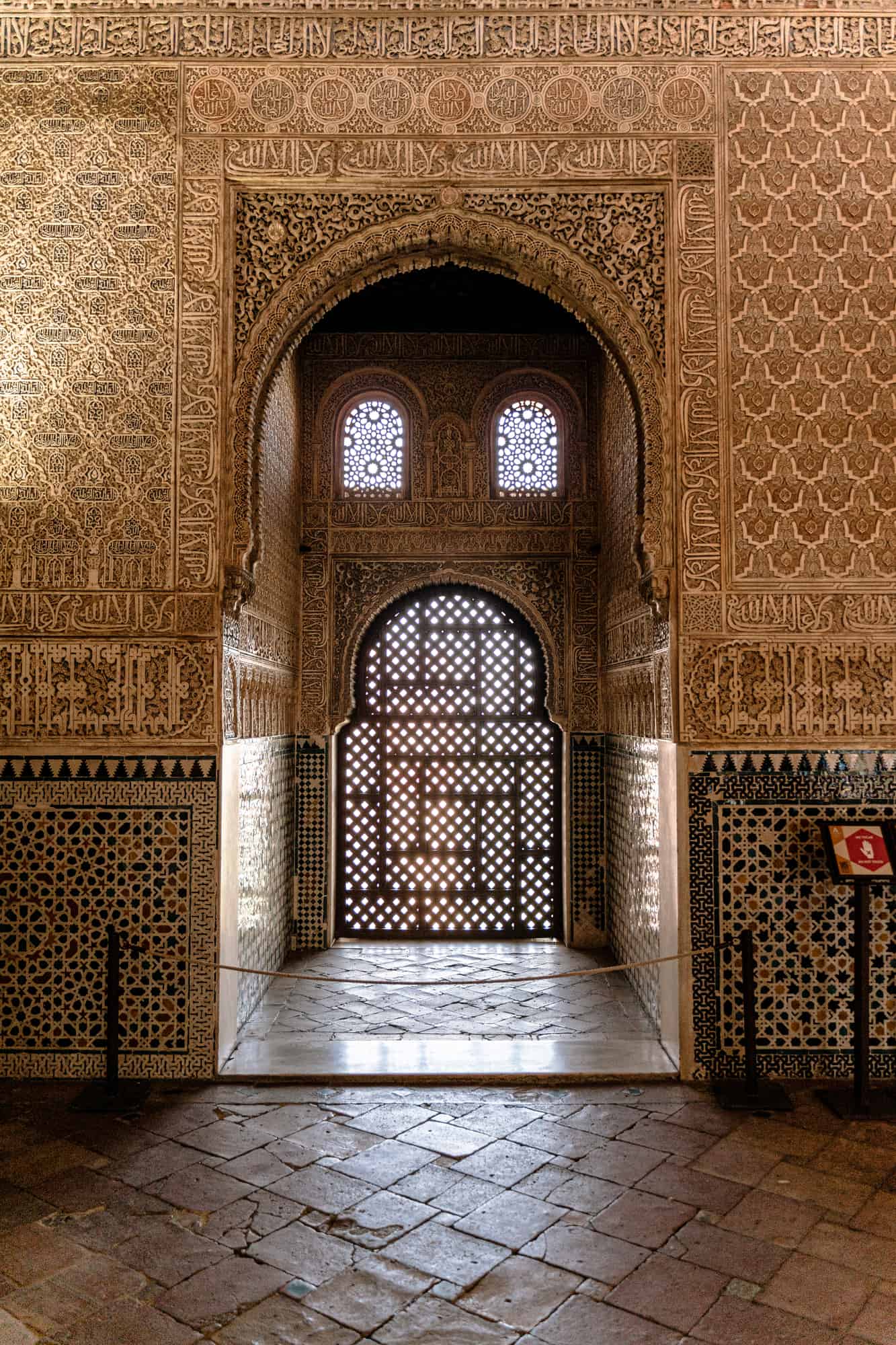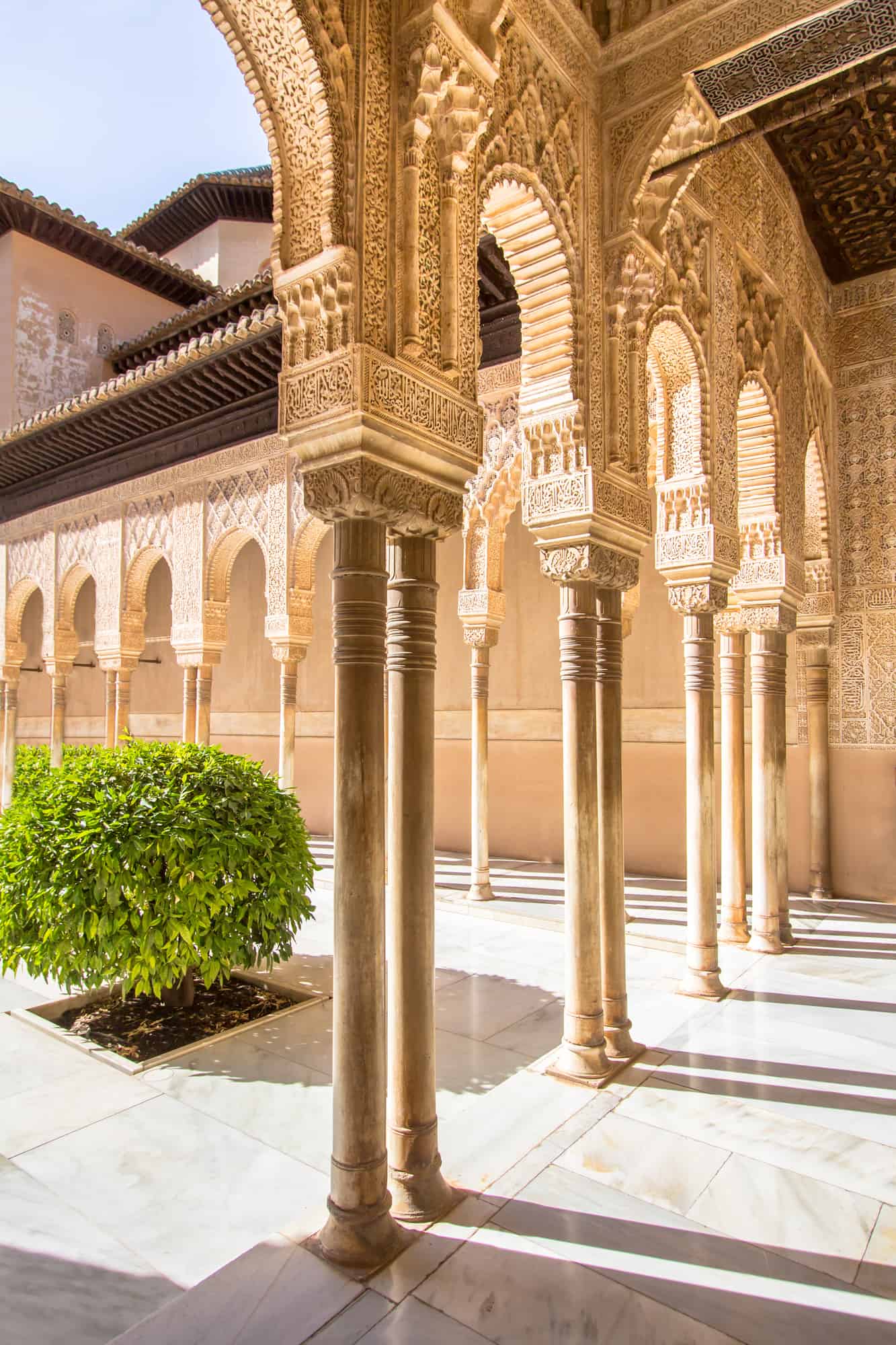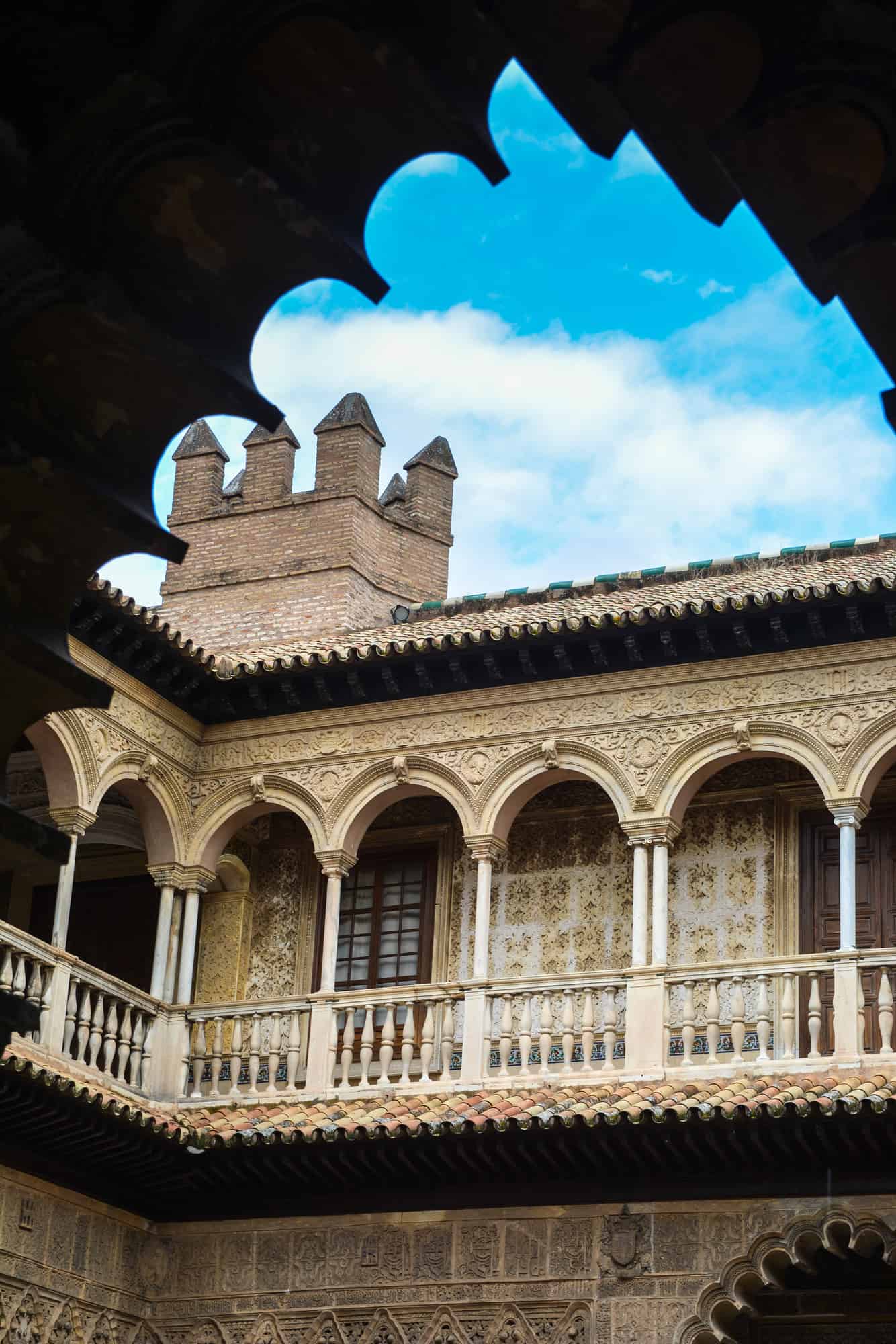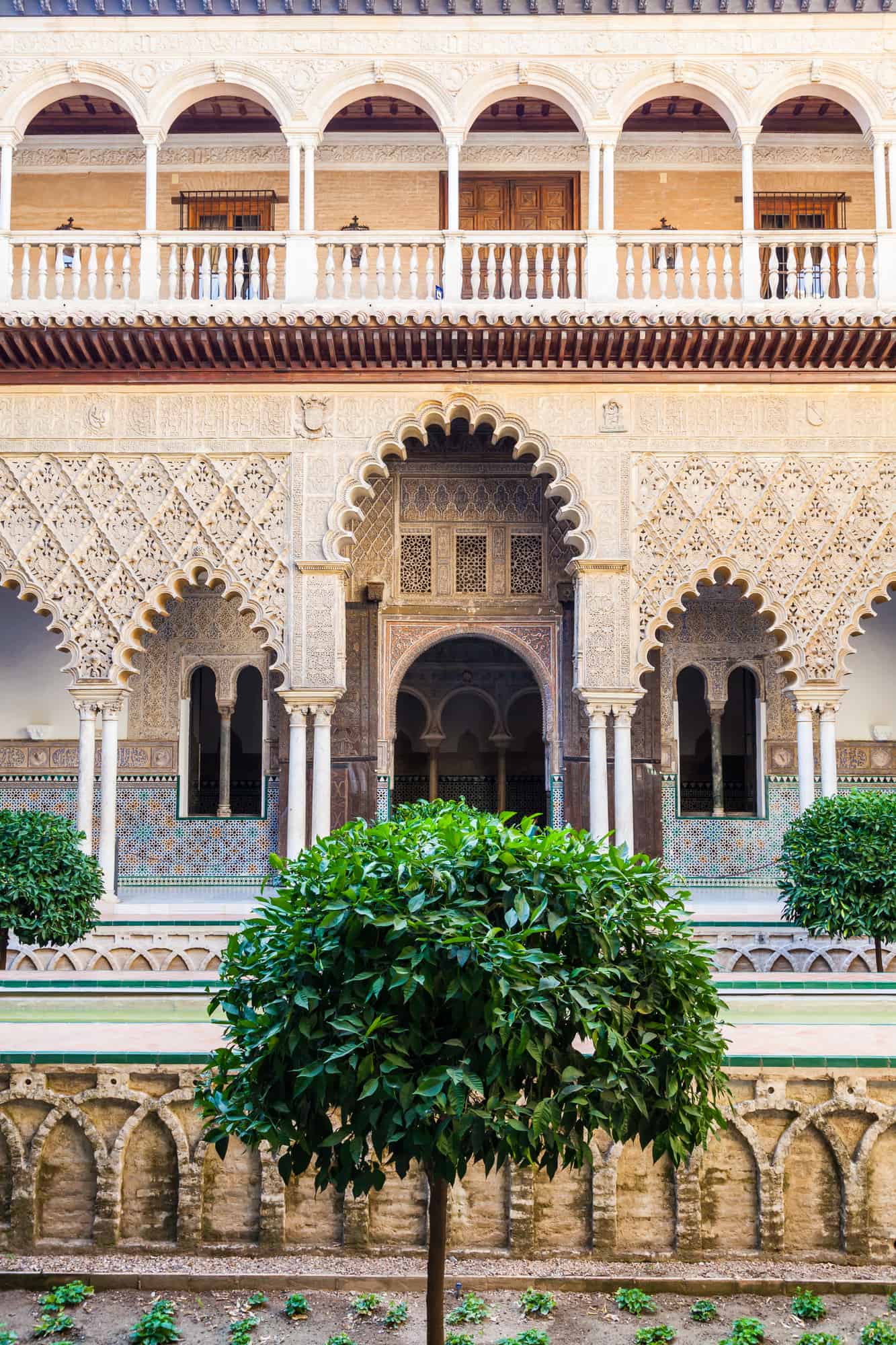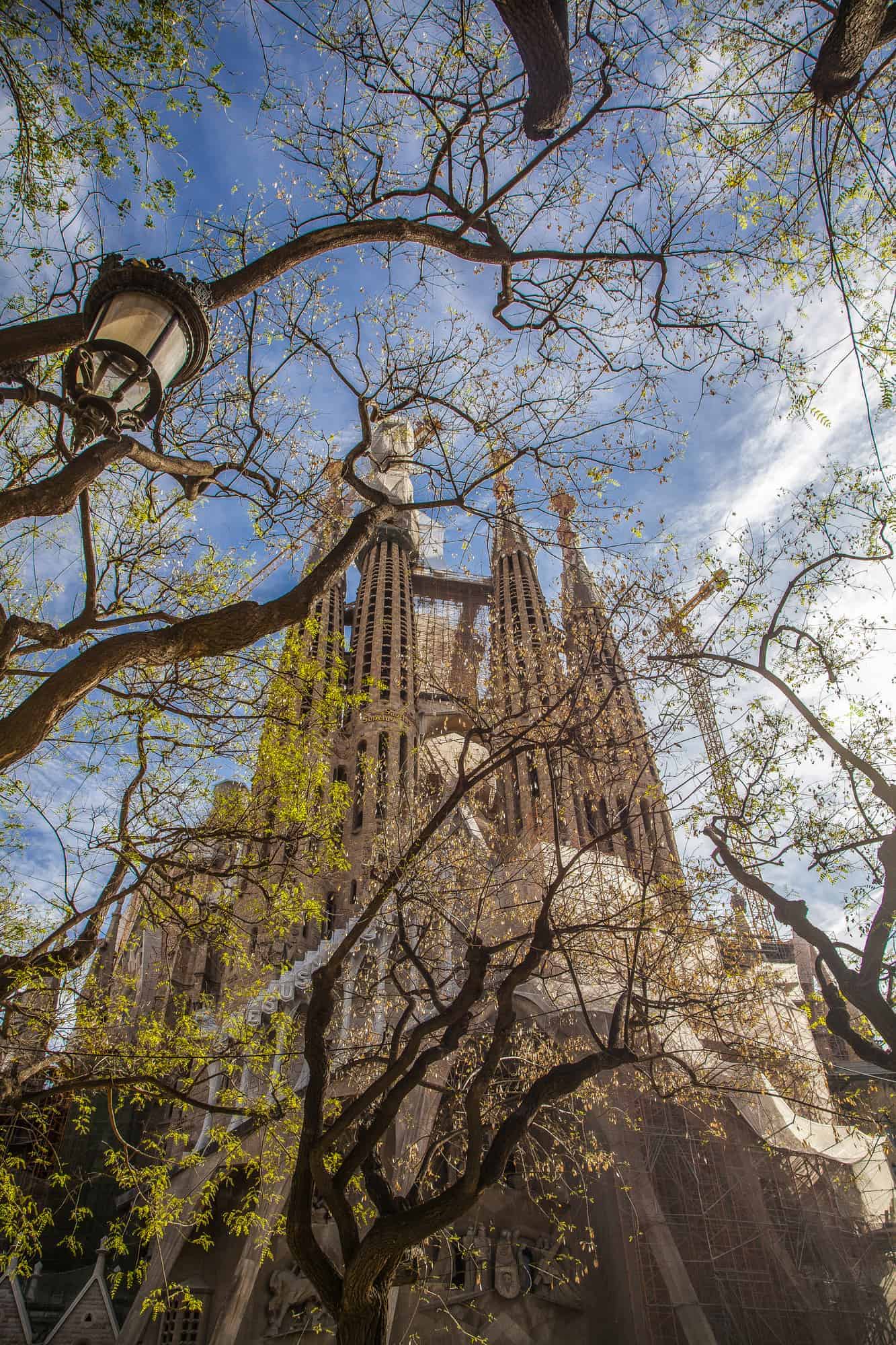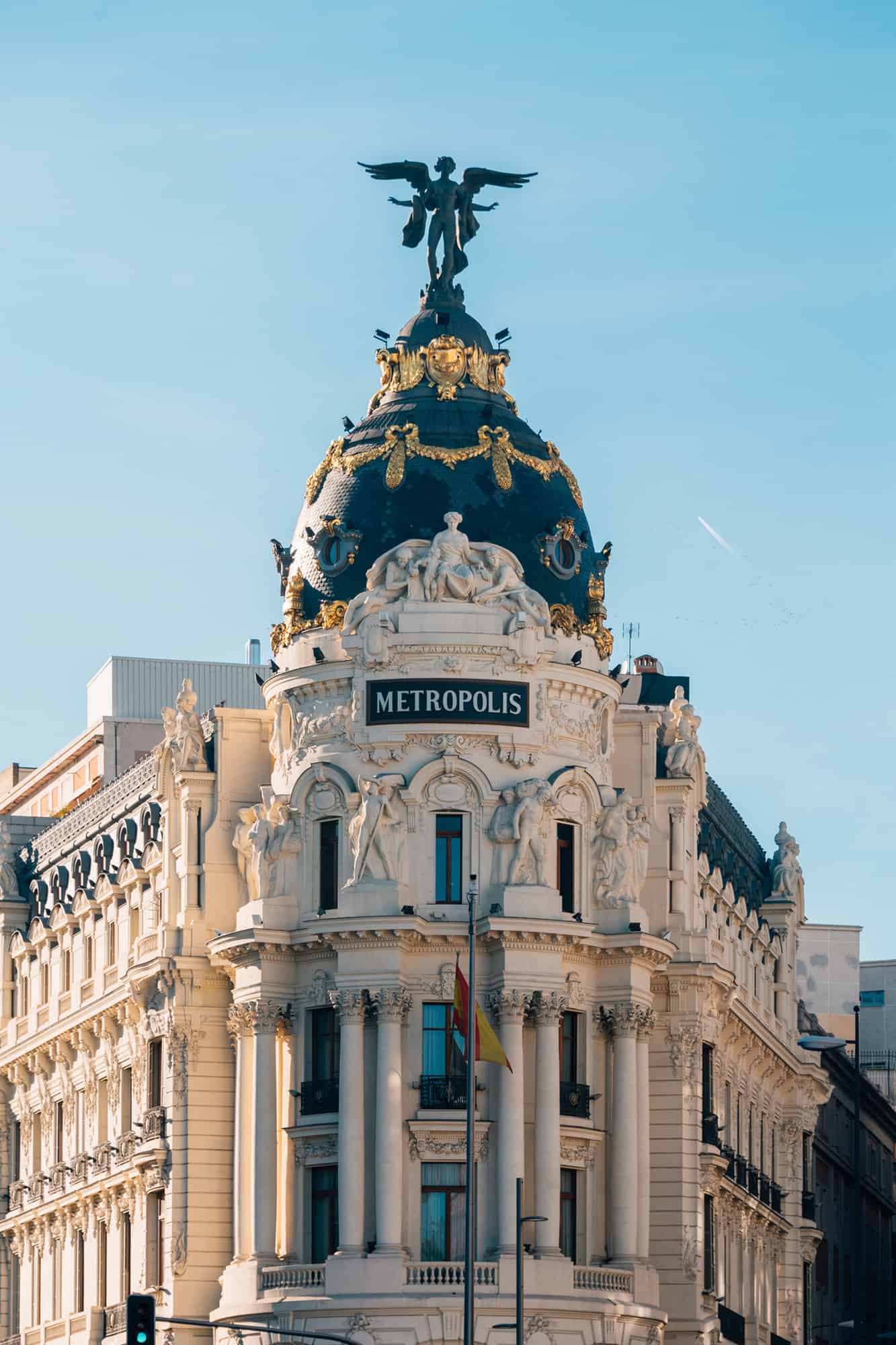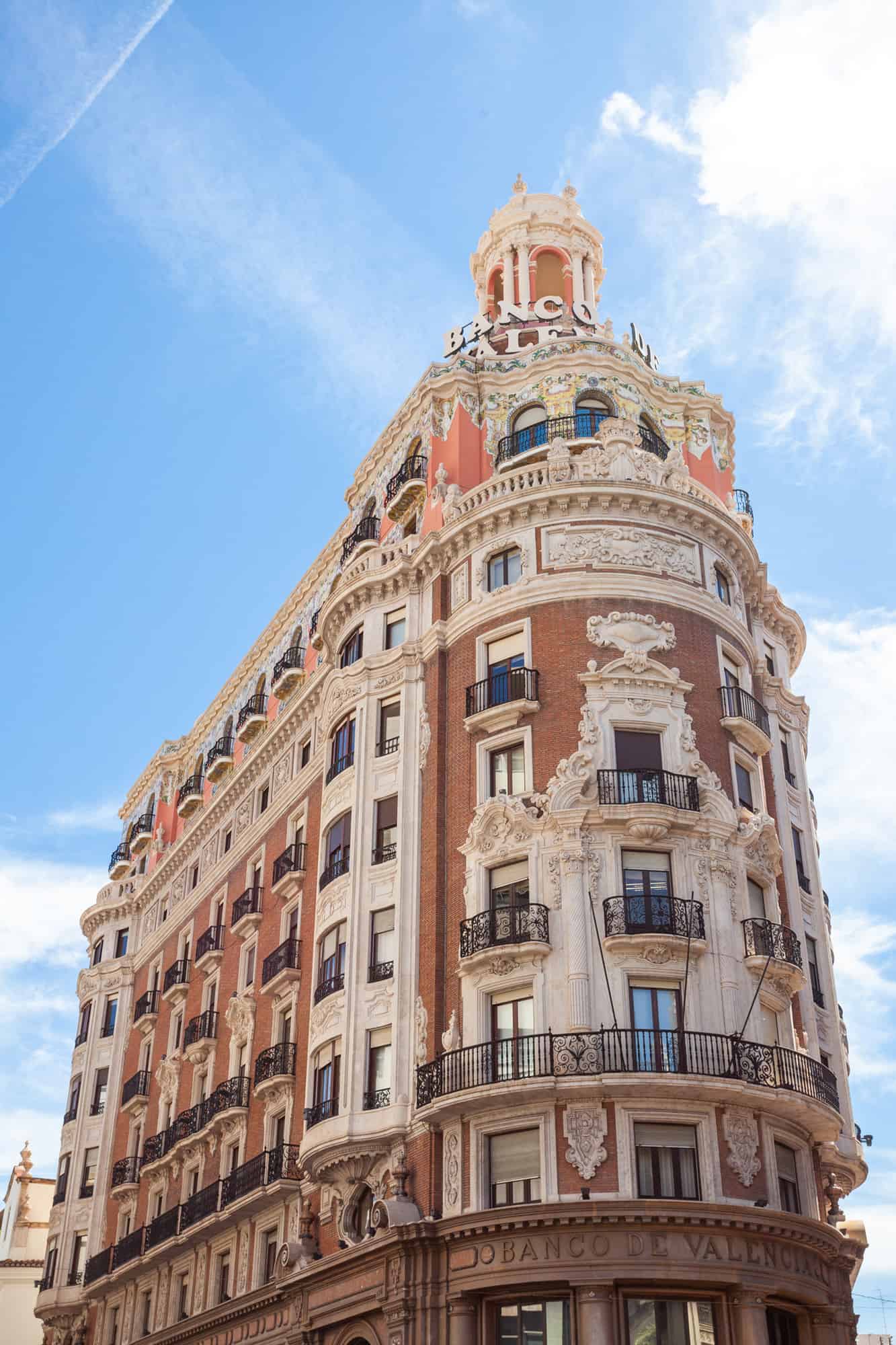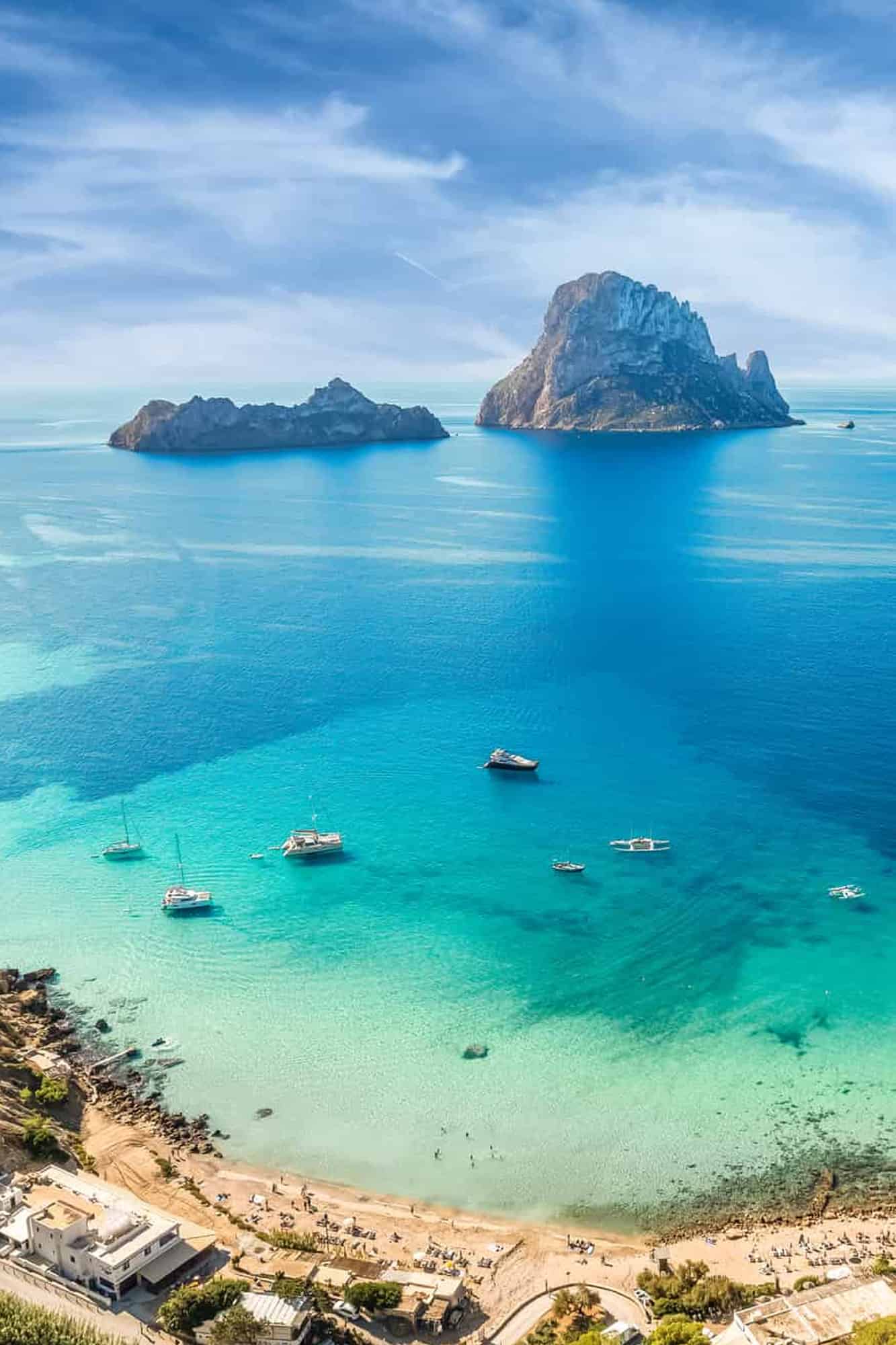Moorish Architecture in Spain
Who were the Moors? And how did they come to create Muslim architecture in Spain? To answer the first question, the Moors were a diverse group of mixed Arab, Berber, and Spanish descent. They ruled Spain (particularly the region known today as Andalucia) during the Middle Ages for several centuries. During this time, they constructed architectural masterpieces which still stand today, including the Alhambra of Granada, Mesquita of Cordoba, and the Real Alcázar of Seville. In this article, I’ll cover the top 12 Islamic sites worth visiting on your next trip to Spain, so you don’t miss a thing!


Hi, we’re Timon & Filipa!
We travel across Spain in our motorhome, Speedy, and update TravelSpain24 with fresh content, practical tips, and personal stories from the road. Our goal is to help you experience Spain beyond the typical tourist trails.
What is Moorish Architecture?
Moorish architecture is a style derived from the Muslim rule of Spain and North Africa. It is unique – unlike any other kind found in Western Europe. Nature scenes and geometry characterize the tiles, and reliefs are etched with Islamic calligraphy. The interiors of buildings feature ornate horseshoe arches and columns, and outside courtyards and reflective pools act as central points.
Is there Islamic architecture in Spain?
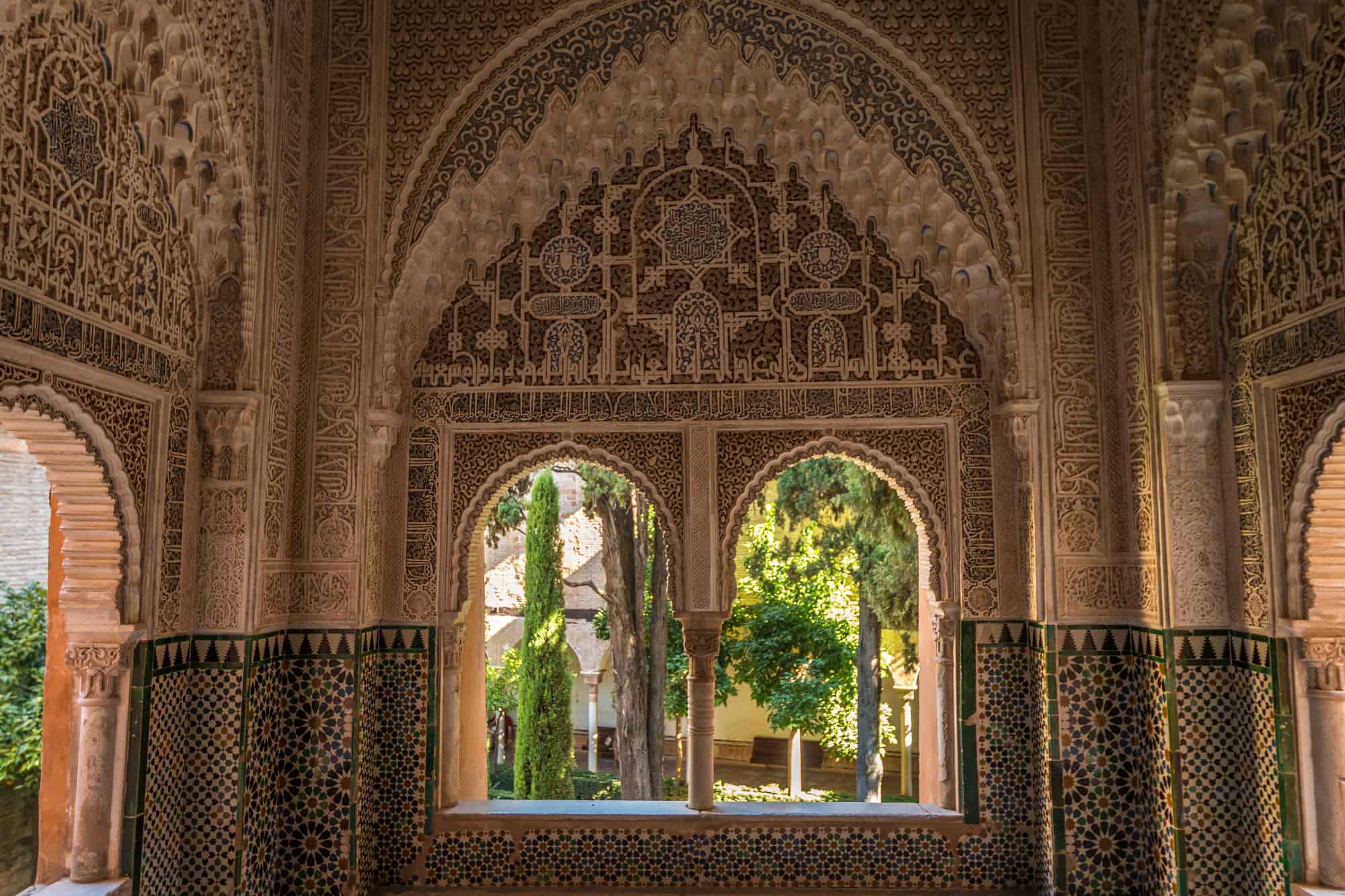
Yes, lots of well-preserved examples still stand today. Muslim architecture in Spain is located mainly across the southern provinces of Andalucia, then much further north in Toledo and Zaragoza.
Why is there Arabic architecture in Spain?
Arabic architecture exists in Spain due to a long period of rule by the Moors during the Middle Ages. After they conquered the land and settled in Spain, they began to colonize specific regions.
The Moors built huge fortifications for defense, mosques to worship, and impressive palaces for their leaders to live in. There’s also evidence that they constructed quarries in the Sierra Nevada region near Granada – a place from which they could source materials to build their myriad masterpieces.
Islamic architecture, design & art
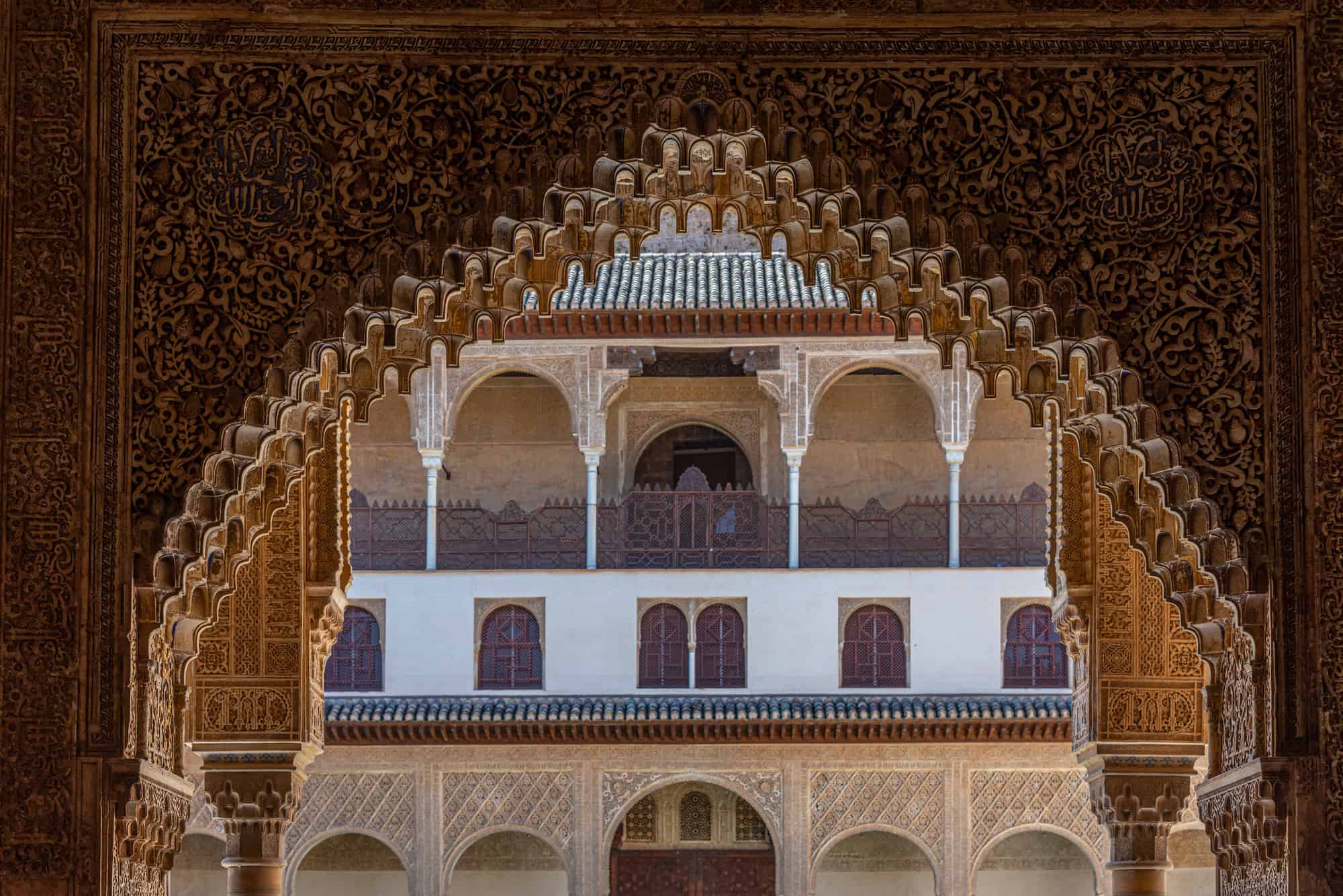
During the Middle Ages, new architectural designs were beginning to emerge throughout the Arab Kingdom, North Africa, and the Iberian Peninsula. Decorative tiles known as “Zellij” were hand-crafted with complex geometric patterns to symbolize the mathematics of the universe. Domes represented the Islamic religion, graced many mosques and palaces’ rooftops, and crenelated. Lancet arches in a horseshoe shape portrayed grand entrances into their domains.
Some of the most prominent elements of Islamic architecture are shown in the form of courtyards, reflective pools, and “Muqarnas” designs. Muqarnas is ornamental vaulting resembling a honeycomb, usually set beneath a building’s dome, entrance, or roof. The designs can be made from different materials, including stucco, wood, tiles, or stone. Some of the best examples of Muqarnas can be found at the Alhambra Palace in Granada.
Geometry
Sacred geometry is a key factor in Muslim architecture. It is considered a connection to a higher source and aligns with the Islamic religion, which forbids animals and humans to be depicted in places of worship. The geometric designs were considered self-expression, created with mathematical precision to symbolize universal unity and order. Many design examples can be seen with stars, multi-sided polygons, circles, and squares in buildings throughout Spain and Northern Africa.
Botany (nature)
Other designs, such as botany, also began to emerge. These designs were heavily influenced by trees, flowers, plants, and vines to showcase the richness of the land and all that nature provides.
Calligraphy
Architects and wordsmiths discovered that decorative pieces could also hold messages that would last centuries when placed on or inside structures. Calligraphy was added to tiles and other areas of architectural design to convey poetry and religious scripture to the masses.
Where can I find Moorish Architecture in Spain?
You can find Moorish architecture throughout Spain, although the highest concentration of structures can be found in the eight provinces that make up Andalucia – Seville, Granada, Huelva, Córdoba, Cádiz, Málaga, Jaén, and Almeria.
1. Alhambra Palace, Granada
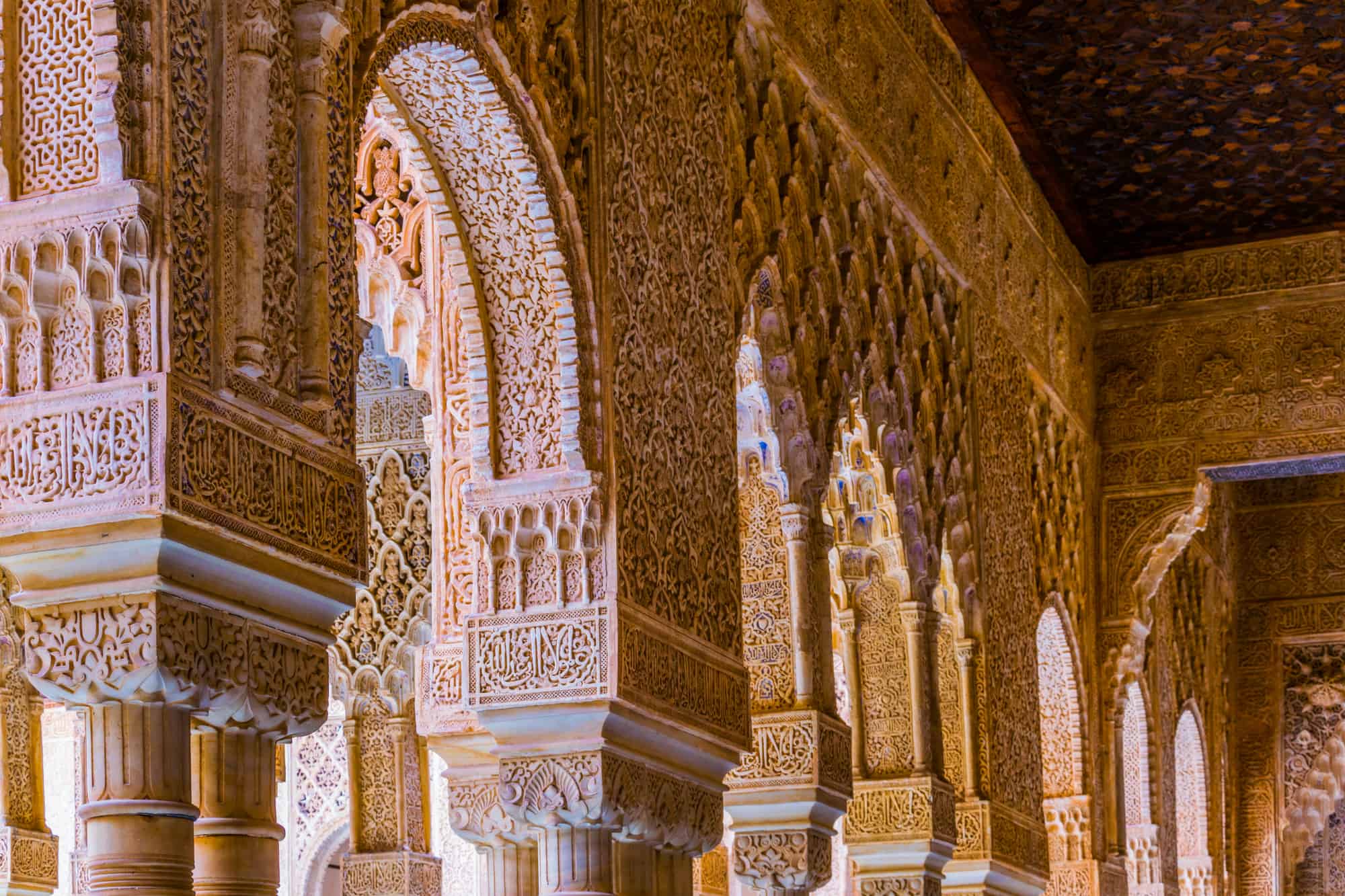
If you want to see the best examples of Moorish architecture in the world, Alhambra Palace in Granada is the place to be. Nestled atop a hillside overlooking the Albayzin (old Arabic Quarter of Granada) and flanked by a backdrop of the Sierra Nevada mountains, it is a sight to behold. The Alhambra Palace is an entire complex – a veritable feast of breathtaking architecture, and you’ll need at least a day to explore and fully appreciate it.
You can see almost every example of Moorish architecture in one place with horseshoe arches, Arabesque and Muqarba ceiling designs, reflective pools, calligraphy, and beautiful gardens. Highlights not to miss during your tour include the Nasrid Palaces, Court of the Myrtles, Partal Palace, and the Generalife Gardens.
Before going to Granada, planning your visit according to the season would be beneficial, since the weather can significantly impact your experience. To ensure you choose the best time for your visit, check out our guide that discusses Granada’s weather month by month.
Tours & tickets: Alhambra (Alhambra de Granada)
2. Cuarto Real de Santo Domingo, Granada
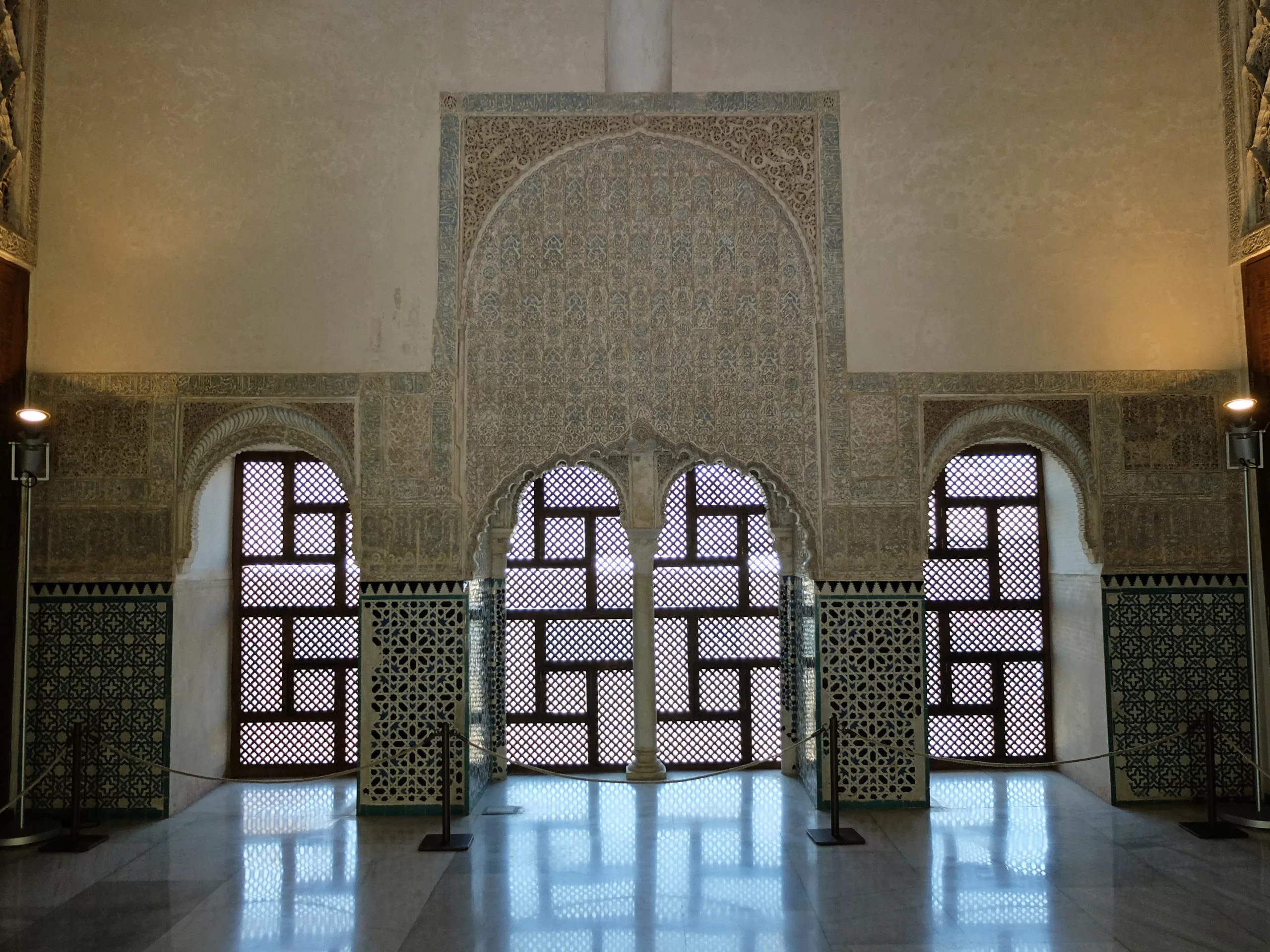
Cuarto Real de Santo Domingo was built between 1273 and the early 1300s – a predecessor of the Nasrid Palace of the Alhambra, therefore mirroring many of the decorative motifs. With etched ornamental panels, latticework and hanging central arches, it is another must-see example of Muslim architecture in Spain.
This, the former Royal Quarters, was once an ancient palace used to serve the Muslim people of Granada during Ramadan. It was originally thought to be a palace and orchard, and although little of the initial structure remains, many key features and elements have been preserved over time.
Must-see areas include the Arabic tower, the Qubba, the ornamental inscriptions, geometrical and nature tile work.
Tours & tickets: Royal Chapel of Granada (Capilla Real)
3. Mezquita Catedral, Córdoba
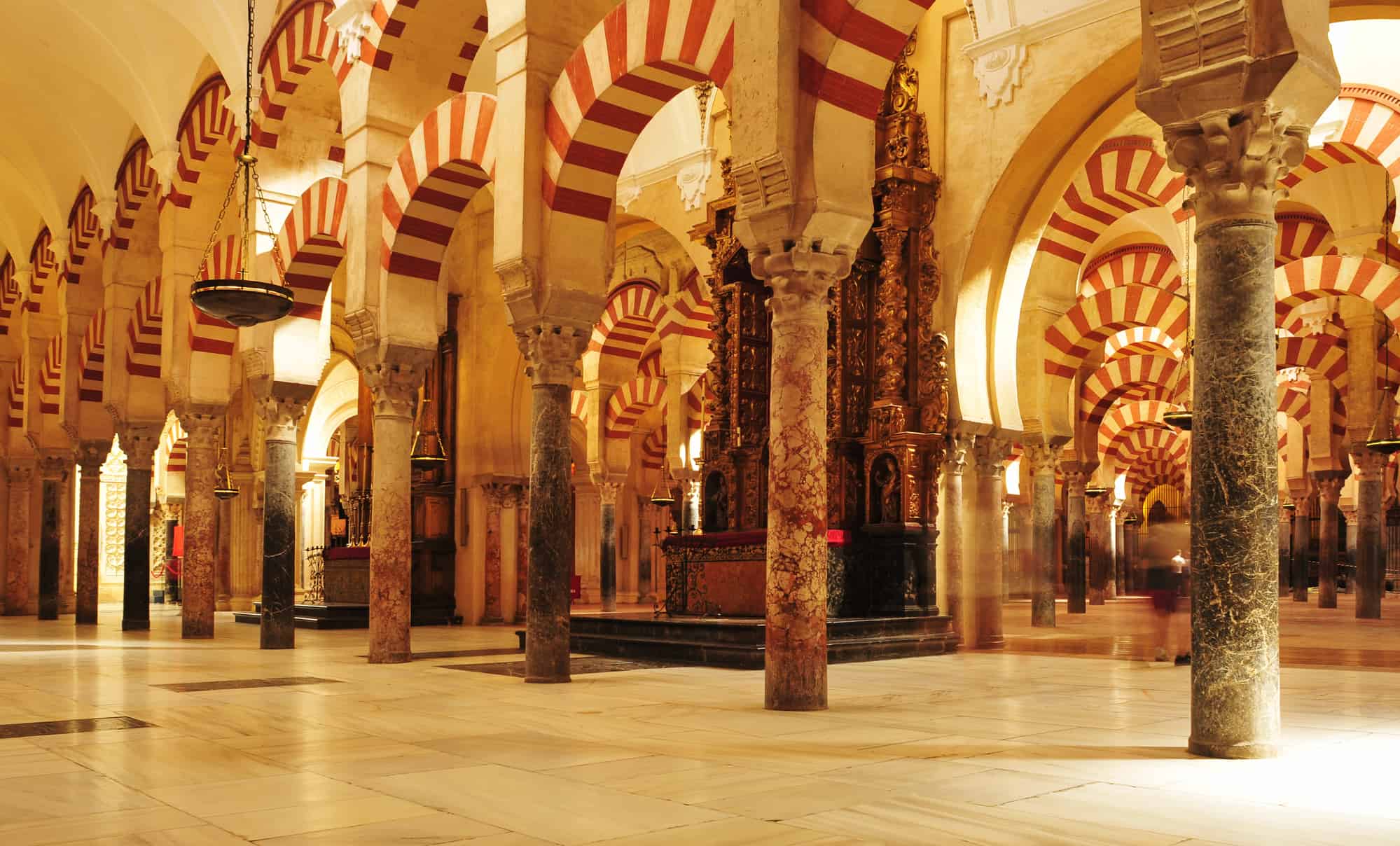
The Mezquita of Córdoba was the city’s former mosque – now a cathedral. It’s one of the world’s largest temples, constructed with Arabic columns in marble, jasper and granite. The construction of this masterpiece took 200 years to complete, and today, a courtyard filled with orange trees and outer naves enhances the already impressive structure.
The Mezquita is best known for its white and red arches across 850 columns, constructed from remnants of the Roman temple that had previously stood on the site. And since the Mezquita became a Christian cathedral, many additions have been made, including Baroque altars and Renaissance domes.
It’s a great place to discover different religions in one place – their stories and histories are told through the architecture of each era.
Tours & tickets: Mezquita (Mosque-Cathedral of Córdoba)
4. Real Alcázar, Sevilla
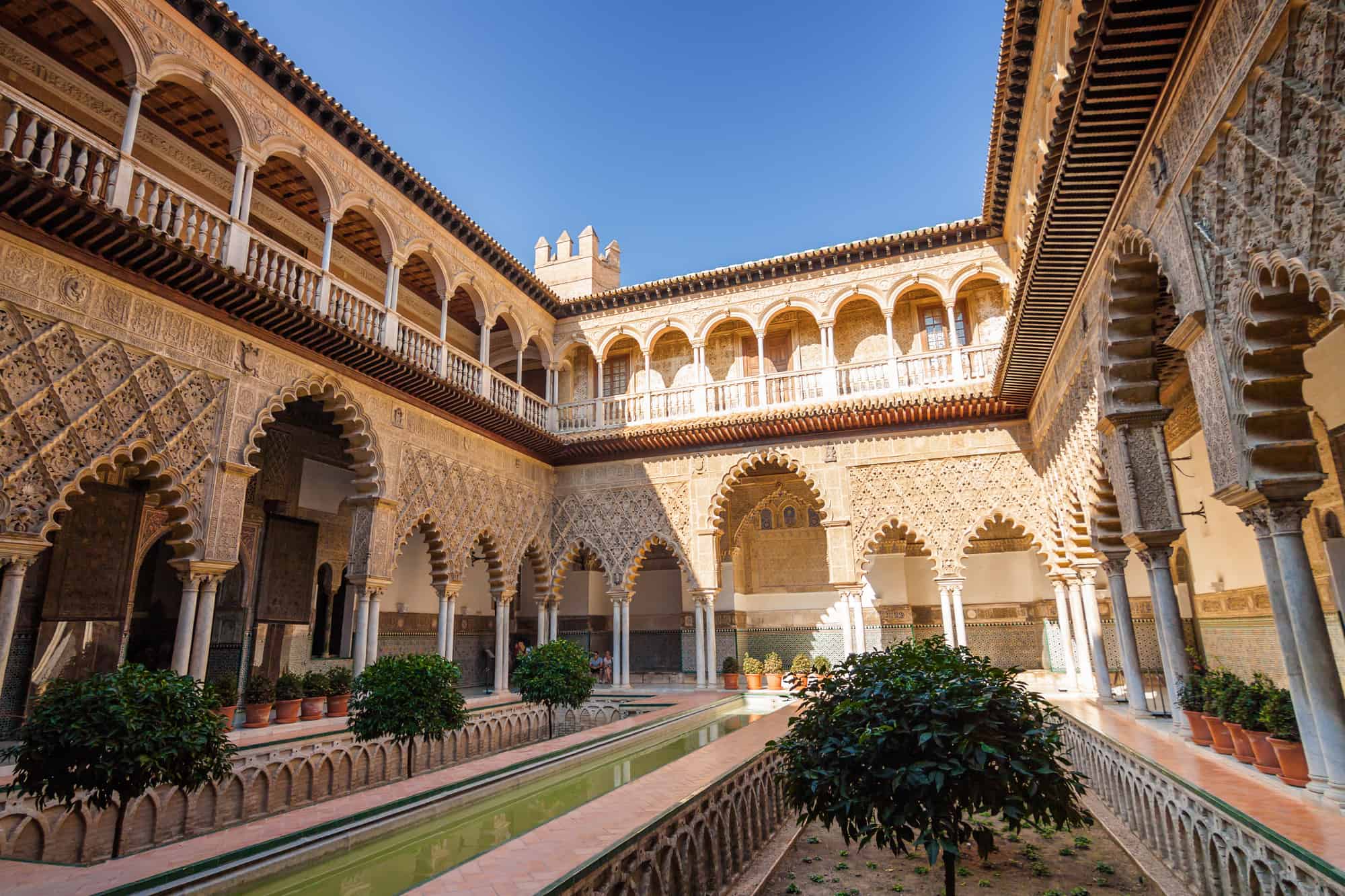
This stunning palace in the heart of Seville is one of the city’s most iconic landmarks and has joined a lengthy list of UNESCO World Heritage Sites in Spain. It’s tucked away opposite the famous Seville Cathedral and is the oldest palace on the continent still used today.
One great aspect of the Real Alcázar is that it is split into sections, each showcasing a different architectural style ranging from Moorish to Baroque.
You can glimpse courtyards and gardens of Patio de las Doncellas and admire salons with their intricately tiled walls and archways. Also, don’t miss a visit to Salon de Embajadores to learn all about the Mudéjar decoration style.
Tours & tickets: Royal Alcázar of Seville (Real Alcázar de Sevilla)
5. La Giralda, Sevilla
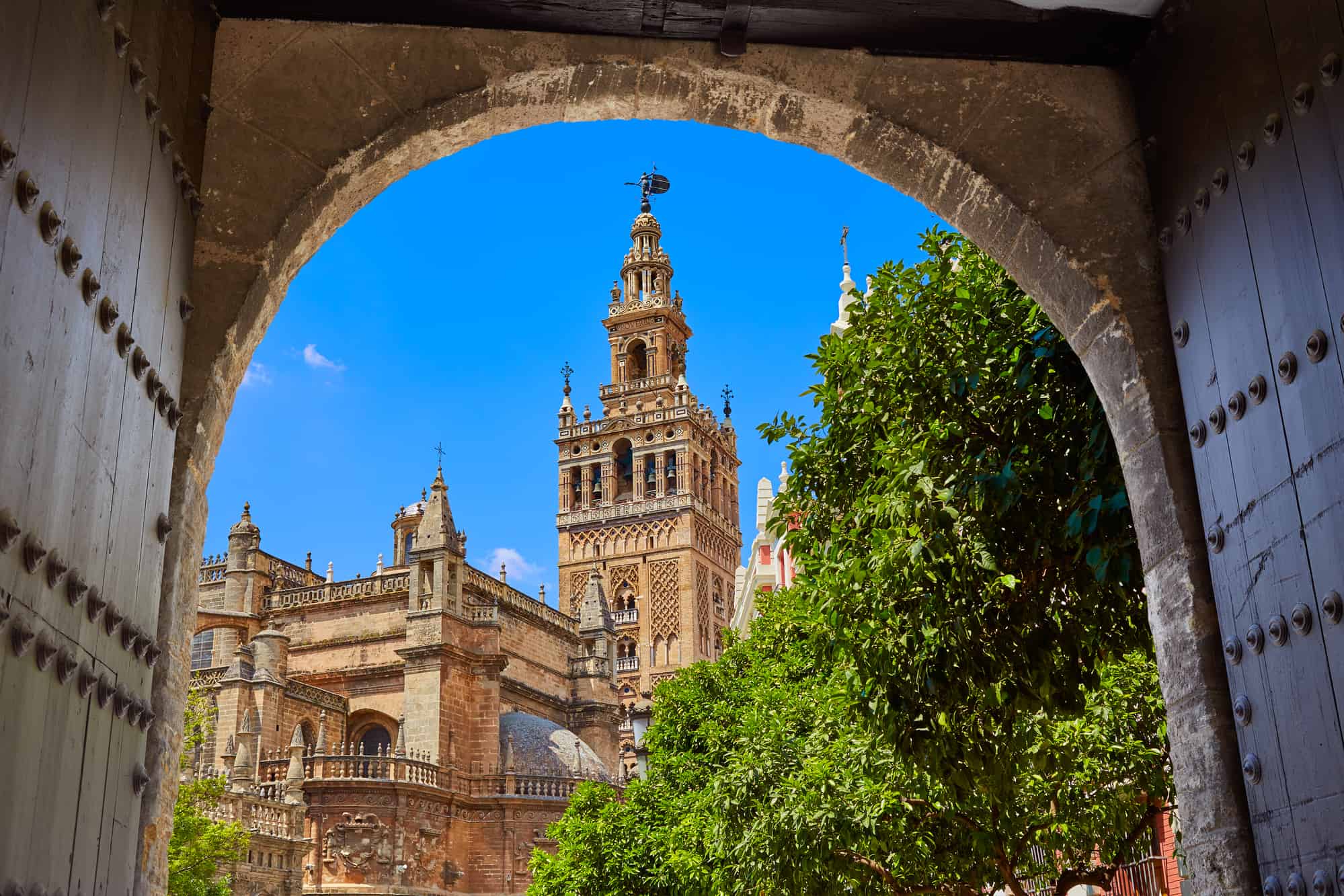
Adjoining Seville Cathedral, La Giralda – the bell tower, is an impressive feat of Moorish architecture, even from the outside.
Familiar archways, latticework, and mock balconies characterize it. Built in the late 1100s, it is said to be modeled on the Koutoubia Mosque in Morocco. The purpose of the building was initially to be the world’s largest minaret. However, this never came to fruition, and after the Christian takeover of Andalucia, it was repurposed as the city’s bell tower instead.
Visitors can climb to the observation platform for incredible views of Seville. The surrounding land is equally impressive, brimming with other Moorish traits, including an Almohad-style courtyard with orange trees and a reflective pool.
Tours & tickets: The Giralda (El Giraldillo)
6. Medina Azahara, Córdoba
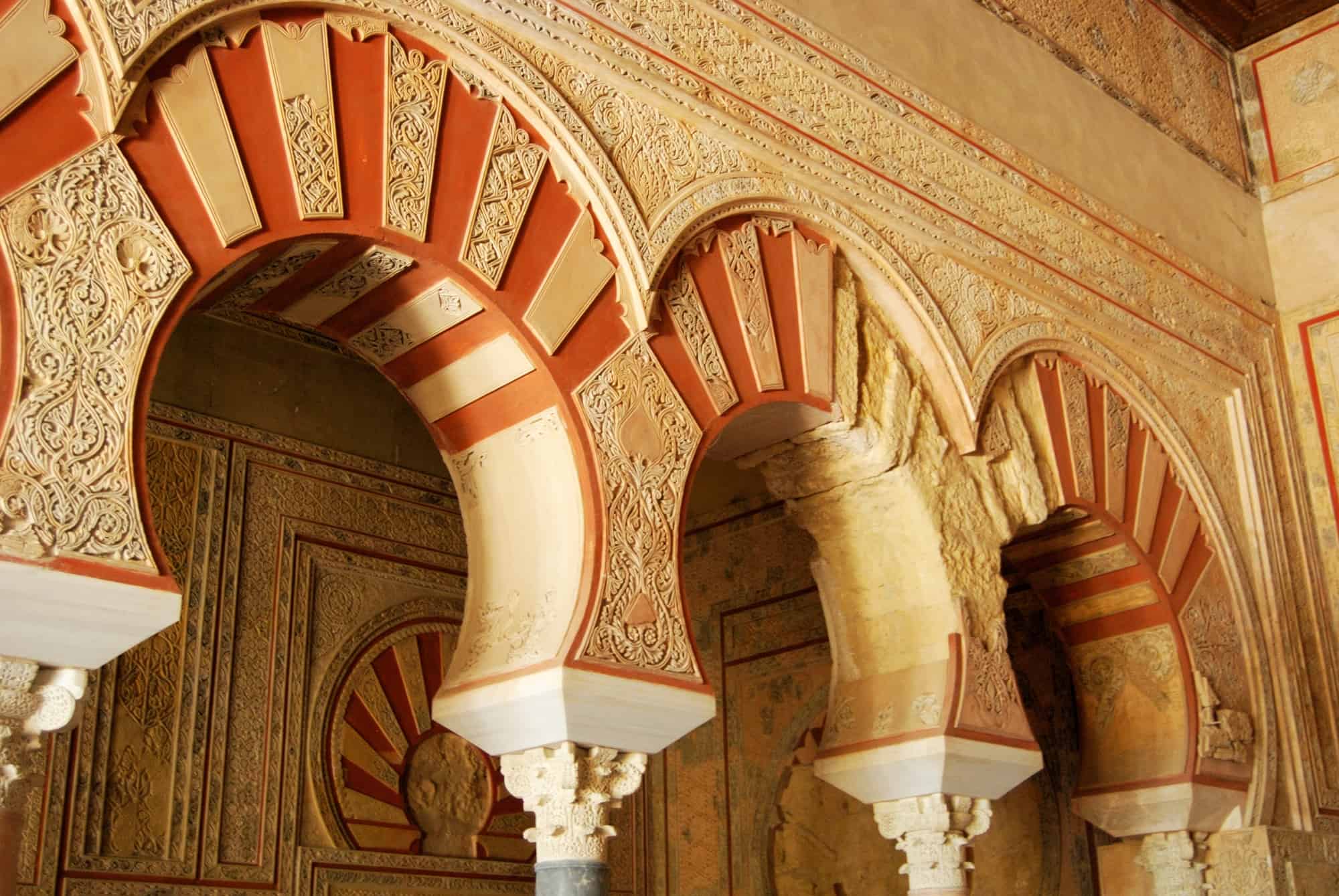
Located on the outer fringes of Córdoba, Medina Azahara or Al-Zahra is a fortified palace dating back to the 10th century. It was built by the first Caliph of the region, known at the time as Al-Andalus, and became its governmental center over the years.
The medina was structured in three tiers and protected by a vast city wall. Walking around what remains of the archaeological site today, you can easily see where the royal castle once stood high in the center.
As you explore, don’t miss the mosque outside the city walls and the High and Rich Halls. The latter are known for their keyhole-shaped red and white marble arches and etched plant motifs, showcasing the Moors’ love of all things of nature.
Guided Tour: Medina Azahara
7. Aljaferià, Zaragoza
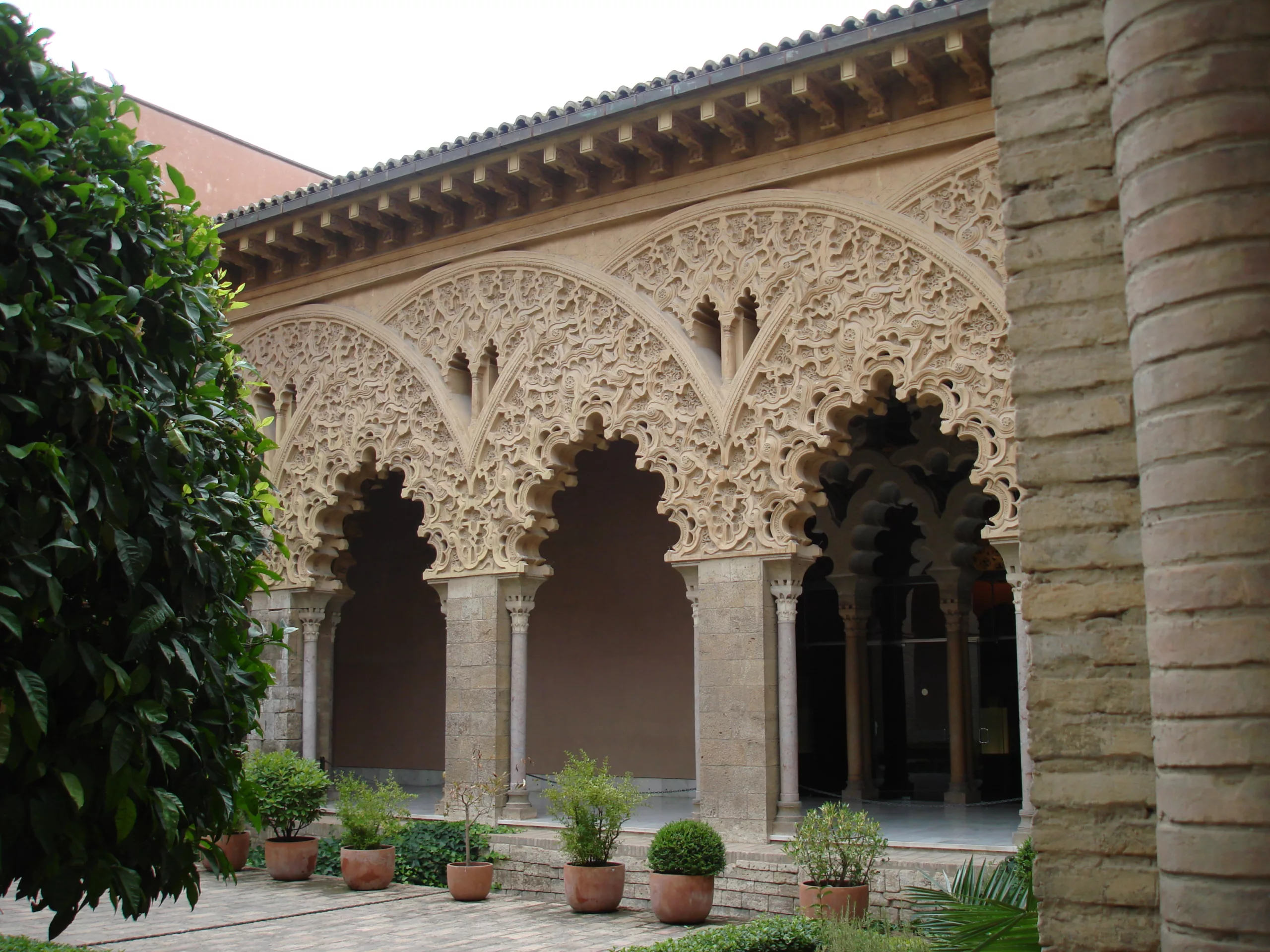
One of the few northern Spanish examples of Muslim architecture in Spain, Aljaferià Palace is located in the charming city of Zaragoza. The 11th-century leisure palace built for the Taifas kings has great examples of Islamic carvings, botanical motifs, and Arabesques.
Don’t miss a trip to Troubadour Tower to see horseshoe arches dating to the 10th century and visit the Golden Hall with its wood-carved ceilings and birdlife filigrees. Also, the north side halls offer some impressive calligraphic and floral reliefs.
Explore the courtyard of Santa Isabel, a serene spot with intricate decoration and a topiary. The architecture that followed the times of the Moors also provides insight into the changing landscapes of Spain.
Zaragoza: Private Tour with a Local Guide
8. Alcazaba, Malaga
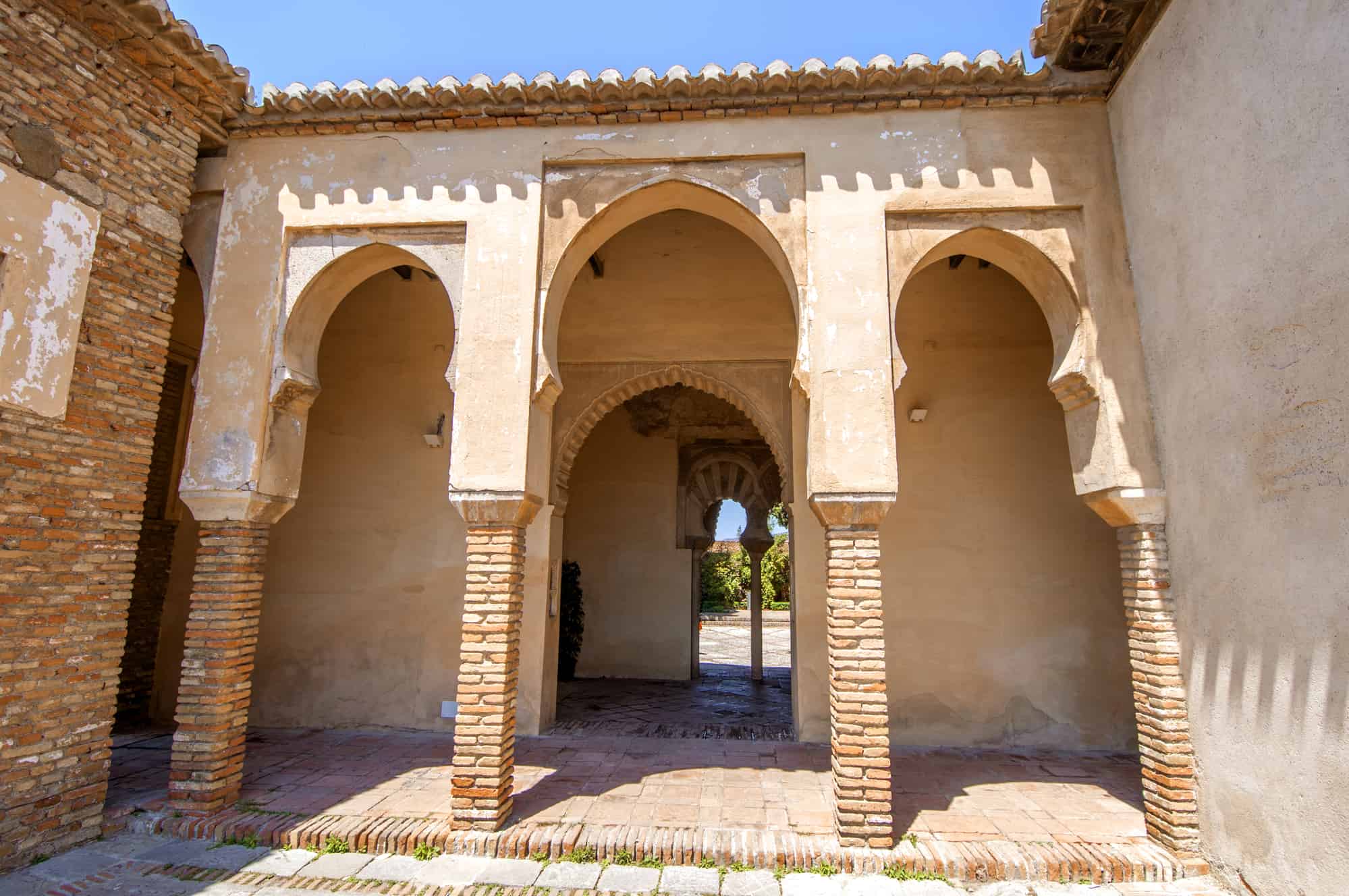
The Alcazaba sits in the coastal city of Malaga – elevated slightly on a hill overlooking the sea. It was said to be built between the 11th century, and completed in the 14th century. It is one of the most well-preserved Moorish sites in Spain.
This is where centuries and civilizations intersect – a 1st-century Roman amphitheater on-site and all of the additions after the Alcazaba.
The Moorish influence can be observed at Puerta de las Columnas with its horseshoe archway and the inner citadel. In the Taifa Palace of the southern pavilion, Caliphal arches line the entrance – many etched with Arabesque decorations. In the Nasrid palace and its patios, reflective pools beneath an open sky are present alongside the original tiled paving.
Malaga has its own weather peculiarities. So, plan accordingly using our comprehensive article on the best time to visit Malaga.
Tours & tickets: Malaga Alcazaba
9. Castle of Gormaz, Gormaz
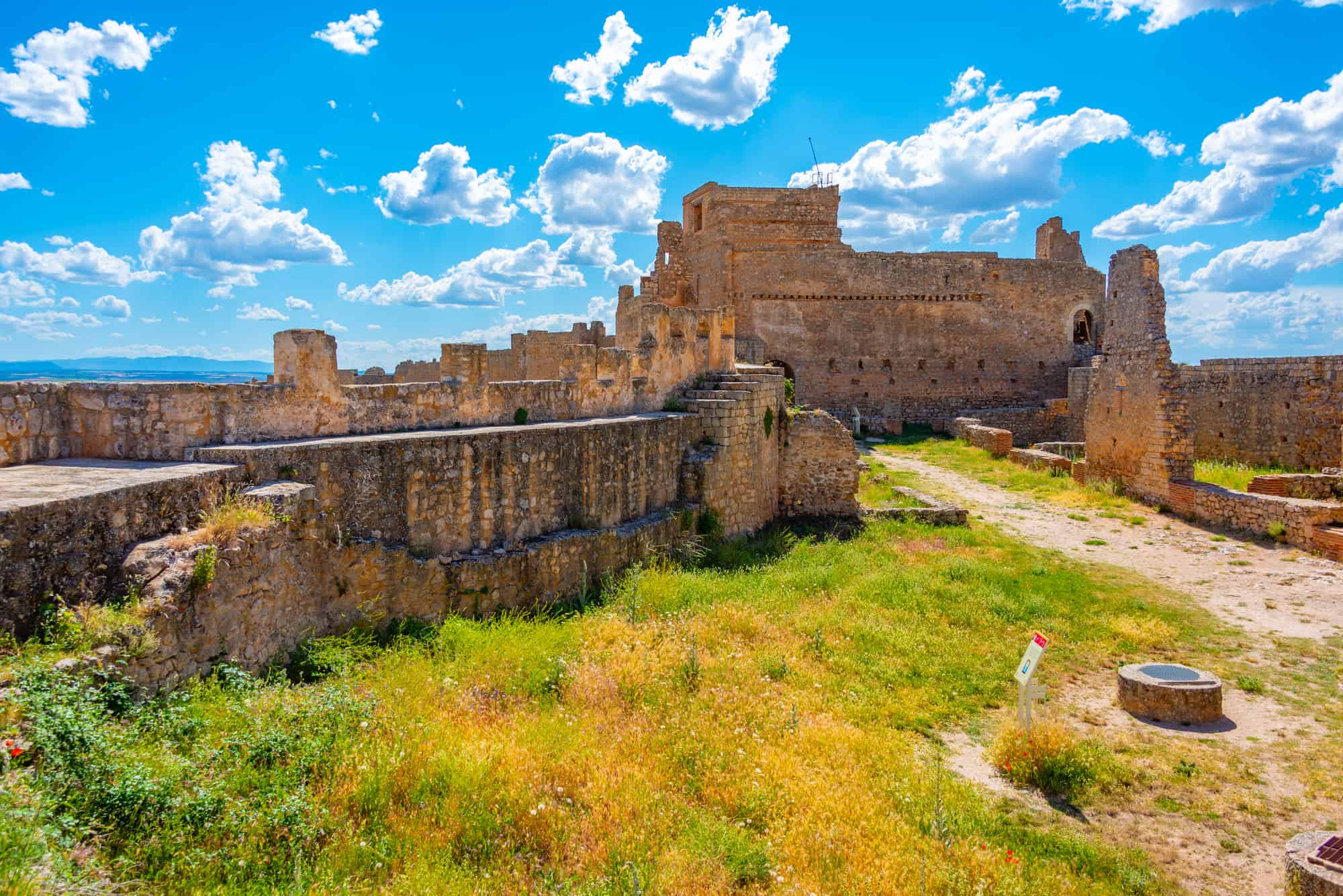
Originally constructed in the mid-700s before being expanded during the 10th century to prevent attacks on the Caliphate of Cordoba, the Castle of Gomaz is a superb example of Muslim architecture in Spain.
What remains of the castle in Castille-Leon province today highlights the architectural prowess and stonemasonry used by the Moors at the time.
Walk by the walls to see where the moat was once filled, see the watch towers, and where the armory stood. The best way to view the entire castle is to hike from the foot of the hill up the trail, and while doing so, look out for remnants of ceramics and stonework that can still be seen on the ground in the area.
10. Torre del Oro, Seville
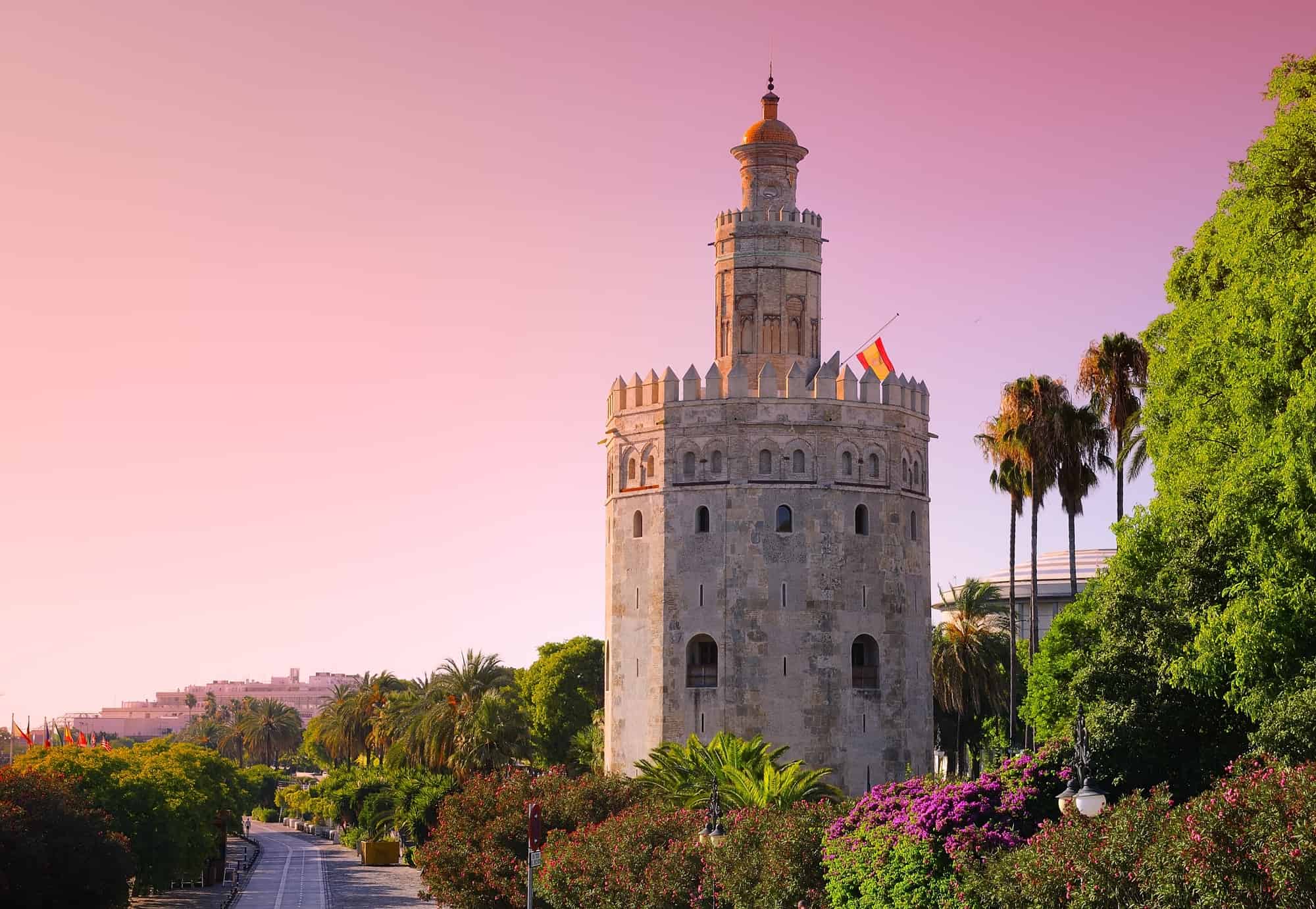
Palm trees line Seville’s Torre del Oro on the shores of the Guadalquivir River. The tower dates to the early 1200s, built by the Almohad Moors. The tower was designed to defend the city from river invaders and today stands as a much-loved landmark of Seville.
You can climb to the observation deck of the Golden Tower for incredible views and visit the Naval Museum inside, showcasing model ships, maritime artifacts, and maps from expeditions to the Americas.
It’s a wonderfully-preserved example of Moorish architecture in the city and can be added to an itinerary alongside a visit to the Real Alcázar and La Giralda.
Tours & tickets: Torre del Oro
11. Calahorra Tower, Córdoba
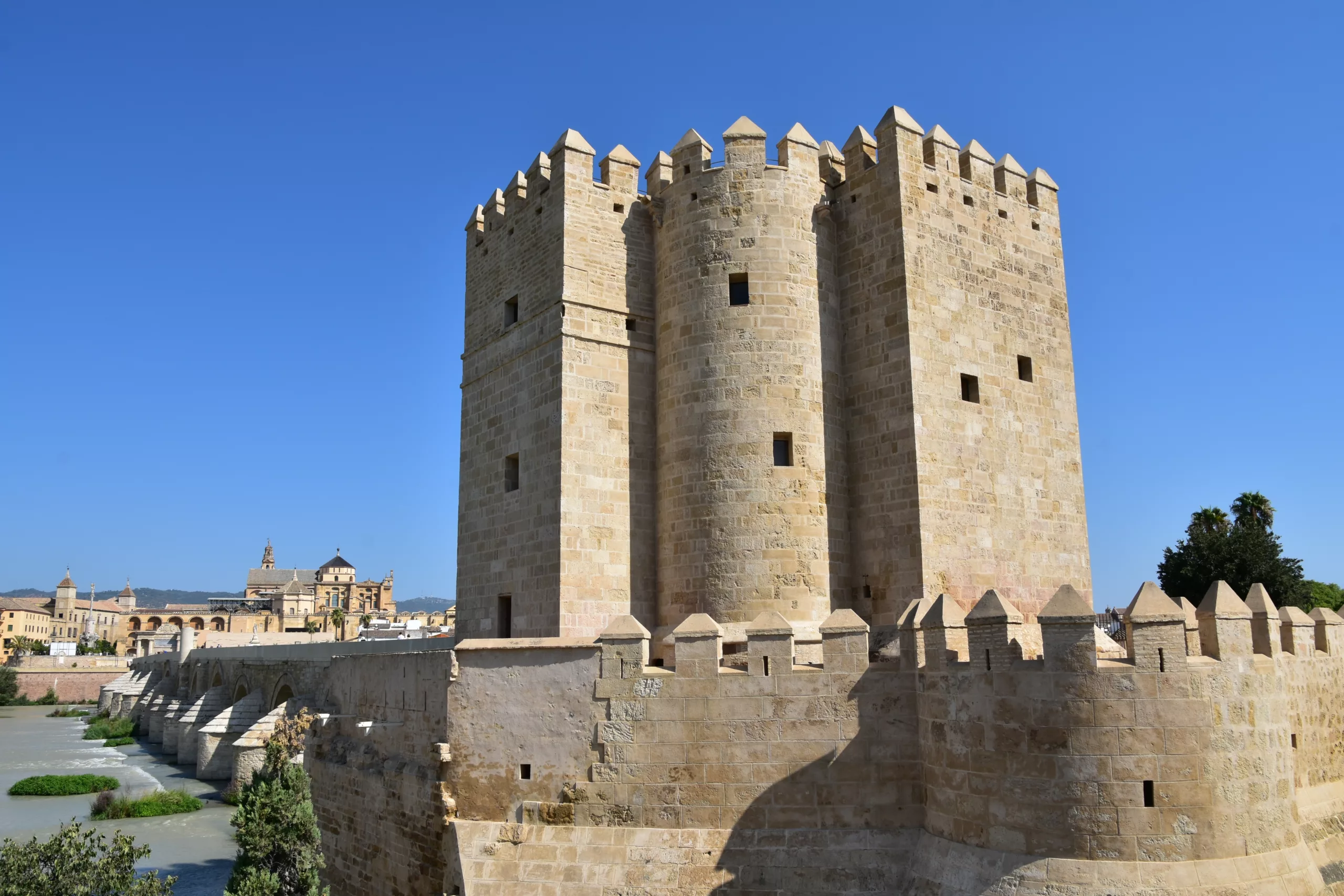
Located in the historic center of Córdoba, Calahorra Tower is one of Andalucia’s most famous Islamic gates and towers. The Almohads constructed it to protect the River Guadalquivir bridge so that watchers could see enemies approaching from far away.
It sits on the south side of the Roman bridge and, since the 12th century, has been utilized for numerous purposes, including a prison and school.
Today, travelers can walk across the bridge, imagining what life was like during those times, and visit the Living Museum of Al-Andalus to learn more about the Moors during their era of Spanish rule.
Tours & tickets: Cordoba Tours, Activities and Attractions
12. Cristo de la Luz, Toledo
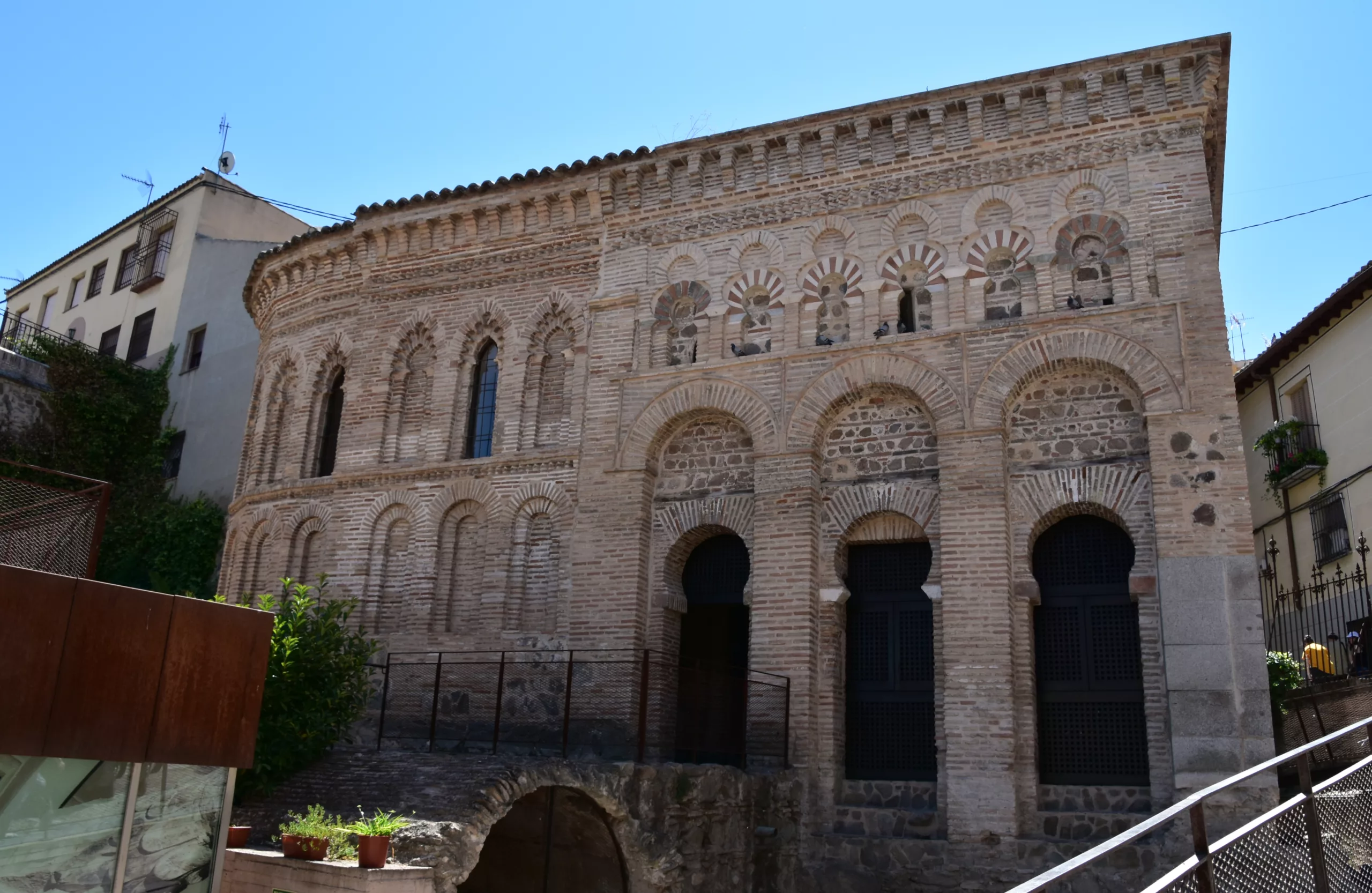
This former mosque, now a Catholic chapel, dates back to the year 1000. Ten mosques once stood in Toledo – today, this is the only remaining one. It boasts well-preserved examples of Mudéjar architecture and art and is an important monument in the city.
As you step inside, admire the interior decorated with ribbed vaults and horseshoe arches, and in the mosque, seek out the inscriptions and plaster etchings from the 10th century.
The architecture both inside and out, is a feat of engineering, particularly when you consider that it still stands in the heart of a city with many modern structures surrounding it.
Tours & tickets: Mosque of Christ of the Light (Mezquita Del Cristo De La Luz)
Itinerary: Muslim Architecture in Spain
If you want to see as many great examples of Islamic architecture as possible during your trip to Spain, I suggest an itinerary similar to this.
Start your trip in Malaga. Visit the Alcazaba, a beautiful old building. Then, take a bus or drive to Granada. Spend two days here. Don’t miss the Alhambra Palace and the Albayzin area.
Next, head to Cordoba. Be sure to see the Mezquita, a famous mosque, and the Calahorra Tower.
Finish your trip in Seville. Spend two or three days here. There’s lots to see, including amazing buildings and museums.
Alternatively, choose the attractions and cities you wish to see the most! Wherever you decide to visit, the Moorish architecture of Spain is a joy to discover during any season.
Final Thoughts
Interestingly, most of the cities mentioned here, including Granada, Cordoba, Zaragoza, and Malaga, are some of Spain’s cheapest places to live. This is great news if you’re considering an extended stay or perhaps even relocating.
Lastly, if you’re traveling with family, you might want to consider Seville and Malaga. These cities have been selected as some of the best places to live in Spain with family in 2024. These destinations offer a mix of culture, history, and a family-friendly environment, making them ideal for expat families.
Whichever route you choose, you’ll be in awe of the captivating Muslim architecture in Spain. Enjoy your trip!
Search the site
Popular Destinations
Just letting you know
When you buy something through our links, we’ll earn a small commission—don’t worry, it won’t cost you any extra! It’s a win-win, right?
Exclusive Heymondo Travel Insurance Offer
Planning a trip? Make sure you’re covered! We’ve teamed up with Heymondo to give our readers a special deal: 5% off travel insurance. Grab this deal and know you’re looked after on your next trip.

